Zirconia Nanoparticles as Reinforcing Agents for Contemporary Dental Luting Cements: Physicochemical Properties and Shear Bond Strength to Monolithic Zirconia
Abstract
:1. Introduction
2. Results
2.1. Fourier Transform Infrared Spectroscopy (FTIR) Characterization
2.2. Water Sorption and Solubility
2.3. Film Thickness
2.4. Estimation of Flexural Strength
2.5. Shear Bond Strength Results
2.6. Failure Mode Results
3. Discussion
4. Materials and Methods
4.1. Preparation and Characterization of Nanoparticles
4.2. Zirconia Specimen Preparation
4.3. Incorporation of Zirconia NPs into Luting Cements
4.4. Investigation of Physical and Mechanical Properties of Modified Luting Cements
4.4.1. FTIR Analysis
4.4.2. Evaluation of Water Sorption and Solubility
4.4.3. Estimation of Film Thickness
4.4.4. Determination of Flexural Strength
4.4.5. Preparation of Specimens for Adhesive Bonding
4.4.6. Shear Bond Strength to Translucent Zirconia Substrate
4.4.7. Failure Mode Analysis
4.5. Statistical Analysis
5. Conclusions
- The addition of NPs did not significantly change the physicochemical and mechanical properties of the investigated luting cements, except for the case of the RMGI cement, where a significant increase in flexural strength was recorded.
- The addition of NPs at the concentration of 2.5% wt increased the film thickness in all luting agents, however, the values were kept below 30 μm for the RMGI, 40 μm for 10-MDP, and 35 μm for the 4-META cement.
- The application of 1% wt NPs did not significantly affect the DC% values for all of the composite cements, but greater amounts resulted in a dose dependent reduction in the DC% values up to 7.2% for the 4-META and 15.5% for 10-MDP cement.
- The application of an adhesive primer increased the initial SBS values significantly for all commercial products, however, it was beneficial only in RMGI after thermocycling (~16.12% increase).
- Thermocycling presented a detrimental effect on most of the groups after the addition of NPs.
- The 10-MDP-containing luting cements demonstrated higher SBS values compared to the RMGI cements and luting cements with 4-META.
Author Contributions
Funding
Institutional Review Board Statement
Informed Consent Statement
Data Availability Statement
Acknowledgments
Conflicts of Interest
References
- Kontonasaki, E.; Rigos, A.E.; Ilia, C.; Istantsos, T. Monolithic zirconia: An update to current knowledge. Optical properties, wear, and clinical performance. Dent. J. 2019, 7, 90. [Google Scholar] [CrossRef] [PubMed] [Green Version]
- Comba, A.; Baldi, A.; Tempesta, R.M.; Carossa, M.; Perrone, L.; Saratti, C.M.; Rocca, G.T.; Femiano, R.; Femiano, F.; Scotti, N. Do chemical-based bonding techniques affect the bond strength stability to cubic zirconia? Materials 2021, 14, 3920. [Google Scholar] [CrossRef] [PubMed]
- Lopes, G.R.S.; Ramos, N.C.; Grangeiro, M.T.V.; Matos, J.D.M.; Bottino, M.A.; Özcan, M.; Valandro, L.F.; Melo, R.M. Adhesion between zirconia and resin cement: A critical evaluation of testing methodologies. J. Mech. Behav. Biomed Mater. 2021, 120, 104547. [Google Scholar] [CrossRef] [PubMed]
- Quigley, N.P.; Loo, D.S.S.; Choy, C.; Ha, W.N. Clinical efficacy of methods for bonding to zirconia: A systematic review. J. Prosthet. Dent. 2021, 125, 231–240. [Google Scholar] [CrossRef]
- Russo, D.S.; Cinelli, F.; Sarti, C.; Giachetti, L. Adhesion to zirconia: A systematic review of current conditioning methods and bonding materials. Dent. J. 2019, 7, 74. [Google Scholar] [CrossRef] [Green Version]
- Comino-Garayoa, R.; Peláez, J.; Tobar, C.; Rodríguez, V.; Suárez, M.J. Adhesion to zirconia: A systematic review of surface pretreatments and resin cements. Materials 2021, 14, 2751. [Google Scholar] [CrossRef]
- Ban, S. Classification and properties of dental zirconia as implant fixtures and superstructures. Materials 2021, 14, 4879. [Google Scholar] [CrossRef]
- Schünemann, F.H.; Galárraga-Vinueza, M.E.; Magini, R.; Fredel, M.; Silva, F.; Souza, J.C.M.; Zhang, Y.; Henriques, B. Zirconia surface modifications for implant dentistry. Mater. Sci. Eng. C 2019, 98, 1294–1305. [Google Scholar] [CrossRef]
- Tzanakakis, E.G.C.; Skoulas, E.; Pepelassi, E.; Koidis, P.; Tzoutzas, I.G. The use of lasers in dental materials: A review. Materials 2021, 14, 3370. [Google Scholar] [CrossRef]
- De Souza, G.; Hennig, D.; Aggarwal, A.; Tam, L.E. The use of MDP-based materials for bonding to zirconia. J. Prosthet. Dent. 2014, 112, 895–902. [Google Scholar] [CrossRef]
- Tzanakakis, E.-G.C.; Beketova, A.; Papadopoulou, L.; Kontonasaki, E.; Tzoutzas, I.G. Novel Femto Laser Patterning of High Translucent Zirconia as an Alternative to Conventional Particle Abrasion. Dent. J. 2021, 9, 20. [Google Scholar] [CrossRef] [PubMed]
- Tzanakakis, E.; Kontonasaki, E.; Voyiatzis, G.; Andrikopoulos, K.; Tzoutzas, I. Surface characterization of monolithic zirconia submitted to different surface treatments applying optical interferometry and raman spectrometry. Dent. Mater. J. 2020, 39, 111–117. [Google Scholar] [CrossRef] [PubMed] [Green Version]
- Papadogiannis, D.; Dimitriadi, M.; Zafiropoulou, M.; Gaintantzopoulou, M.D.; Eliades, G. Reactivity and bond strength of universal dental adhesives with Co-Cr alloy and zirconia. Dent. J. 2019, 7, 78. [Google Scholar] [CrossRef] [PubMed] [Green Version]
- Müller, N.; Husain, N.A.H.; Chen, L.; Özcan, M. Adhesion of Different Resin Cements to Zirconia: Effect of Incremental versus Bulk Build Up, Use of Mould and Ageing†. Materials 2022, 15, 2186. [Google Scholar] [CrossRef] [PubMed]
- Roberts, H.; Berzins, D.; Nicholson, J. Long-Term Water Balance Evaluation in Glass Ionomer Restorative Materials. Materials 2022, 15, 807. [Google Scholar] [CrossRef] [PubMed]
- Kanchanavasita, W.; Anstice, H.M.; Pearson, G.J. Water sorption characteristics of resin-modified glass-ionomer cements. Biomaterials 1997, 18, 343–349. [Google Scholar] [CrossRef]
- Nicholson, J.W.; Sidhu, S.K.; Czarnecka, B. Enhancing the mechanical properties of glass-ionomer dental cements: A review. Materials 2020, 13, 2510. [Google Scholar] [CrossRef]
- Mitsuhashi, A.; Hanaoka, K.; Teranaka, T. Fracture toughness of resin-modified glass ionomer restorative materials: Effect of powder/liquid ratio and powder particle size reduction on fracture toughness. Dent. Mater. 2003, 19, 747–757. [Google Scholar] [CrossRef]
- Spajić, J.; Prskalo, K.; Šariri, K.; Par, M.; Pandurić, V.; Demoli, N. Dimensional changes of glass ionomers and a giomer during the setting time. Acta Stomatol. Croat. 2018, 52, 293–306. [Google Scholar] [CrossRef]
- Bagheri, R. Film thickness and flow properties of resin-based cements at different temperatures. J. Dent. (Shiraz Iran) 2013, 14, 57–63. [Google Scholar]
- D’Arcangelo, C.; Cinelli, M.; De Angelis, F.; D’Amario, M. The effect of resin cement film thickness on the pullout strength of a fiber-reinforced post system. J. Prosthet. Dent. 2007, 98, 193–198. [Google Scholar] [CrossRef] [PubMed]
- Gjorgievska, E.; Nicholson, J.W.; Gabrić, D.; Guclu, Z.A.; Miletić, I.; Coleman, N.J. Assessment of the impact of the addition of nanoparticles on the properties of glass-ionomer cements. Materials 2020, 13, 276. [Google Scholar] [CrossRef] [PubMed] [Green Version]
- Almutairi, B.; Binhasan, M.; Shabib, S.; Al-Qahtani, A.S.; Tulbah, H.I.; Al-Aali, K.A.; Vohra, F.; Abduljabbar, T. Adhesive bond integrity of silanized zirconia nanoparticles in polymeric resin dentin bonding agent. An FTIR, SEM, and micro-tensile experiment. Int. J. Adhes. Adhes. 2022, 114, 103069. [Google Scholar] [CrossRef]
- Keul, C.; Köhler, P.; Hampe, R.; Roosd, M.; Stawarczyke, B. Glass fiber post/composite core systems bonded to human dentin: Analysis of tensile load vs calculated tensile strength of various systems using pull-out tests. J. Adhes. Dent. 2016, 18, 247–256. [Google Scholar] [CrossRef] [PubMed]
- Walcher, J.G.; Leitune, V.C.B.; Collares, F.M.; de Souza Balbinot, G.; Samuel, S.M.W. Physical and mechanical properties of dual functional cements—An in vitro study. Clin. Oral Investig. 2019, 23, 1715–1721. [Google Scholar] [CrossRef] [PubMed]
- Säilynoja, E.; Garoushi, S.; Vallittu, P.K.; Lassila, L. Characterization of experimental short-fiber-reinforced dual-cure core build-up resin composites. Polymers 2021, 13, 2281. [Google Scholar] [CrossRef]
- Alhotan, A.; Yates, J.; Zidan, S.; Haider, J.; Silikas, N. Assessing fracture toughness and impact strength of PMMA reinforced with nano-particles and fibre as advanced denture base materials. Materials 2021, 14, 4127. [Google Scholar] [CrossRef]
- Zidan, S.; Silikas, N.; Al-Nasrawi, S.; Haider, J.; Alshabib, A.; Alshame, A.; Yates, J. Chemical characterisation of silanised zirconia nanoparticles and their effects on the properties of pmma-zirconia nanocomposites. Materials 2021, 14, 3212. [Google Scholar] [CrossRef]
- Habib, E.; Wang, R.; Wang, Y.; Zhu, M.; Zhu, X.X. Inorganic Fillers for Dental Resin Composites: Present and Future. ACS Biomater. Sci. Eng. 2016, 2, 1–11. [Google Scholar] [CrossRef]
- Heshmatpour, F.; Khodaiy, Z.; Aghakhanpour, R.B. Synthesis and characterization of pure tetragonal nanocrystalline sulfated 8YSZ powder by sol-gel route. Powder Technol. 2012, 224, 12–18. [Google Scholar] [CrossRef]
- Pilo, R.; Kaitsas, V.; Zinelis, S.; Eliades, G. Interaction of zirconia primers with yttria-stabilized zirconia surfaces. Dent. Mater. 2016, 32, 353–362. [Google Scholar] [CrossRef] [PubMed]
- Nagaoka, N.; Yoshihara, K.; Feitosa, V.P.; Tamada, Y.; Irie, M.; Yoshida, Y.; Van Meerbeek, B.; Hayakawa, S. Chemical interaction mechanism of 10-MDP with zirconia. Sci. Rep. 2017, 7, 45563. [Google Scholar] [CrossRef] [PubMed] [Green Version]
- Atsuta, M.; Abell, A.K.; Turner, D.T.; Nakabayashi, N.; Takeyama, M. A new coupling agent for composite materials: 4-Methacryloxyethyl trimellitic anhydride. J. Biomed. Mater. Res. 1982, 16, 619–628. [Google Scholar] [CrossRef] [PubMed]
- Chang, J.C.; Hurst, T.L.; Hart, D.A.; Estey, A.W. 4-META use in dentistry: A literature review. J. Prosthet. Dent. 2002, 87, 216–224. [Google Scholar] [CrossRef] [PubMed]
- Jadhav, S.A. Self-assembled monolayers (SAMs) of carboxylic acids: An overview. Cent. Eur. J. Chem. 2011, 9, 369–378. [Google Scholar] [CrossRef]
- Vouvoudi, E.C.; Baxevani, T.I.; Sideridou, I.D. Dental dimethacrylate-based nanohybrid composite Kalore GC: Kinetic study of its light-curing. J. Taibah Univ. Med. Sci. 2016, 11, 63–71. [Google Scholar] [CrossRef] [Green Version]
- Fernandez Lopez, E.; Sanchez Escribano, V.; Panizza, M.; Carnasciali, M.M.; Busca, G. Vibrational and electronic spectroscopic properties of zirconia powders. J. Mater. Chem. 2001, 11, 1891–1897. [Google Scholar] [CrossRef]
- Beketova, A.; Theocharidou, A.; Tsamesidis, I.; Rigos, A.E.; Pouroutzidou, G.K.; Tzanakakis, E.G.C.; Kourtidou, D.; Liverani, L.; Ospina, M.A.; Anastasiou, A.; et al. Sol–gel synthesis and characterization of ysz nanofillers for dental cements at different temperatures. Dent. J. 2021, 9, 128. [Google Scholar] [CrossRef]
- Kumari, L.; Li, W.Z.; Xu, J.M.; Leblanc, R.M.; Wang, D.Z.; Li, Y.; Guo, H.; Zhang, J. Controlled hydrothermal synthesis of zirconium oxide nanostructures and their optical properties. Cryst. Growth Des. 2009, 9, 3874–3880. [Google Scholar] [CrossRef]
- Chen, Y.; Lu, Z.; Qian, M.; Zhang, H.; Xie, H.; Chen, C. Effect of 10-methacryloxydecyl dihydrogen phosphate concentration on chemical coupling of methacrylate resin to yttria-stabilized zirconia. J. Adhes. Dent. 2017, 19, 349–355. [Google Scholar] [CrossRef]
- Shimizu, H.; Takagaki, T.; Minakuchi, S. Bonding Efficacy of 4-META/MMA-TBB Resin to Surface-treated Highly Translucent Dental Zirconia. J. Adhes. Dent. 2018, 20, 453–460. [Google Scholar] [CrossRef] [PubMed]
- Guerreiro Tanomaru, J.M.; Storto, I.; da Silva, G.F.; Bosso, R.; Costa, B.C.; Bernardi, M.I.B.; Tanomaru-Filho, M. Radiopacity, pH and antimicrobial activity of Portland cement associated with micro- and nanoparticles of zirconium oxide and niobium oxide. Dent. Mater. J. 2014, 33, 466–470. [Google Scholar] [CrossRef] [PubMed] [Green Version]
- Tzanakakis, E.; Tzoutzas, I.; Kontonasaki, E. Zirconia: Contemporary views of a much talked material: Structure, applications and clinical considerations. Zirconia Hel. Stom. Rev. 2013, 57, 101–137. [Google Scholar]
- El-Tamimi, K.M.; Bayoumi, D.A.; Ahmed, M.M.Z.; Albaijan, I.; El-Sayed, M.E. The Effect of Salinized Nano ZrO2 Particles on the Microstructure, Hardness, and Wear Behavior of Acrylic Denture Tooth Nanocomposite. Polymers 2022, 14, 302. [Google Scholar] [CrossRef]
- Aydınoğlu, A.; Yoruç, A.B.H. Effects of silane-modified fillers on properties of dental composite resin. Mater. Sci. Eng. C 2017, 79, 382–389. [Google Scholar] [CrossRef]
- Dai, S.; Chen, Y.; Yang, J.; He, F.; Chen, C.; Xie, H. Surface treatment of nanozirconia fillers to strengthen dental bisphenol a–glycidyl methacrylate–based resin composites. Int. J. Nanomed. 2019, 14, 9185–9197. [Google Scholar] [CrossRef] [Green Version]
- Comba, A.; Paolone, G.; Baldi, A.; Vichi, A.; Goracci, C.; Bertozzi, G.; Scotti, N. Effects of Substrate and Cement Shade on the Translucency and Color of CAD/CAM Lithium-Disilicate and Zirconia Ceramic Materials. Polymers 2022, 14, 1778. [Google Scholar] [CrossRef]
- Sulaiman, T.A.; Abdulmajeed, A.A.; Altitinchi, A.; Ahmed, S.N.; Donovan, T.E. Physical Properties, Film Thickness, and Bond Strengths of Resin-Modified Glass Ionomer Cements According to Their Delivery Method. J. Prosthodont. 2019, 28, 85–90. [Google Scholar] [CrossRef] [Green Version]
- Garner, J.R.; Wajdowicz, M.N.; DuVall, N.B.; Roberts, H.W. Selected physical properties of new resin-modified glass ionomer luting cements. J. Prosthet. Dent. 2017, 117, 277–282. [Google Scholar] [CrossRef]
- Kious, A.R.; Roberts, H.W.; Brackett, W.W. Film thicknesses of recently introduced luting cements. J. Prosthet. Dent. 2009, 101, 189–192. [Google Scholar] [CrossRef]
- Tsukada, G.; Tanaka, T.; Kajihara, T.; Torii, M.; Inoue, K. Film thickness and fluidity of various luting cements determined using a trial indentation meter. Dent. Mater. 2006, 22, 183–188. [Google Scholar] [CrossRef] [PubMed]
- Laiteerapong, A.; Reichl, F.X.; Hickel, R.; Högg, C. Effect of eluates from zirconia-modified glass ionomer cements on DNA double-stranded breaks in human gingival fibroblast cells. Dent. Mater. 2019, 35, 444–449. [Google Scholar] [CrossRef] [PubMed]
- Gavranović-Glamoč, A.; Ajanović, M.; Korać, S.; Zukić, S.; Strujić-Porović, S.; Kamber-Ćesir, A.; Kazazić, L.; Berhamović, E. Evaluation of the water sorption of luting cements in different solutions. Acta Med. Acad. 2017, 46, 124–132. [Google Scholar] [CrossRef] [PubMed]
- Takahashi, M.; Nakajima, M.; Hosaka, K.; Ikeda, M.; Foxton, R.M.; Tagami, J. Long-term evaluation of water sorption and ultimate tensile strength of HEMA-containing/-free one-step self-etch adhesives. J. Dent. 2011, 39, 506–512. [Google Scholar] [CrossRef] [PubMed]
- Li, Z.C.; White, S.N. Mechanical properties of dental luting cements. J. Prosthet. Dent. 1999, 81, 597–609. [Google Scholar] [CrossRef]
- Kawashima, M.; Yamaguchi, S.; Mine, A.; Li, H.; Imazato, S. Novel testing method to evaluate the mechanical strength of self-adhesive resin cements with reflection of cement thickness. Dent. Mater. J. 2021, 40, 1235–1242. [Google Scholar] [CrossRef]
- Ilie, N. Comparative analysis of static and viscoelastic mechanical behavior of different luting material categories after aging. Materials 2021, 14, 1452. [Google Scholar] [CrossRef]
- Kang, L.L.; Chuang, S.F.; Li, C.L.; Lin, J.C.; Lai, T.W.; Wang, C.C. Enhancing Resin Cement Adhesion to Zirconia by Oxygen Plasma-Aided Silicatization. Materials 2022, 15, 5568. [Google Scholar] [CrossRef]
- Kim, M.; Kim, R.H.; Lee, S.C.; Lee, T.K.; Hayashi, M.; Yu, B.; Jo, D.W. Evaluation of Tensile Bond Strength between Self-Adhesive Resin Cement and Surface-Pretreated Zirconia. Materials 2022, 15, 3089. [Google Scholar] [CrossRef]
- Rohr, N.; Brunner, S.; Märtin, S.; Fischer, J. Influence of cement type and ceramic primer on retention of polymer-infiltrated ceramic crowns to a one-piece zirconia implant. J. Prosthet. Dent. 2018, 119, 138–145. [Google Scholar] [CrossRef] [Green Version]
- Yoshihara, K.; Nagaoka, N.; Maruo, Y.; Nishigawa, G.; Yoshida, Y.; Van Meerbeek, B. Silane-coupling effect of a silane-containing self-adhesive composite cement. Dent. Mater. 2020, 36, 914–926. [Google Scholar] [CrossRef] [PubMed]
- Tzanakakis, E.G.; Dimitriadi, M.; Tzoutzas, I.; Koidis, P.; Zinelis, S.; Eliades, G. Effect of Water Storage on Hardness and Interfacial Strength of Resin Composite Luting Agents Bonded to Surface-Treated Monolithic Zirconia. Dent. J. 2021, 9, 78. [Google Scholar] [CrossRef] [PubMed]
- Berzins, D.W.; Abey, S.; Costache, M.C.; Wilkie, C.A.; Roberts, H.W. Resin-modified glass-ionomer setting reaction competition. J. Dent. Res. 2010, 89, 82–86. [Google Scholar] [CrossRef] [PubMed]
- Baldi, A.; Comba, A.; Ferrero, G.; Italia, E.; Michelotto Tempesta, R.; Paolone, G.; Mazzoni, A.; Breschi, L.; Scotti, N. External gap progression after cyclic fatigue of adhesive overlays and crowns made with high translucency zirconia or lithium silicate. J. Esthet. Restor. Dent. 2022, 34, 557–564. [Google Scholar] [CrossRef] [PubMed]
- Hajizadeh-Oghaz, M.; Razavi, R.S.; Estarki, M.L. Large-scale synthesis of YSZ nanopowder by Pechini method. Bull. Mater. Sci. 2014, 37, 969–973. [Google Scholar] [CrossRef]
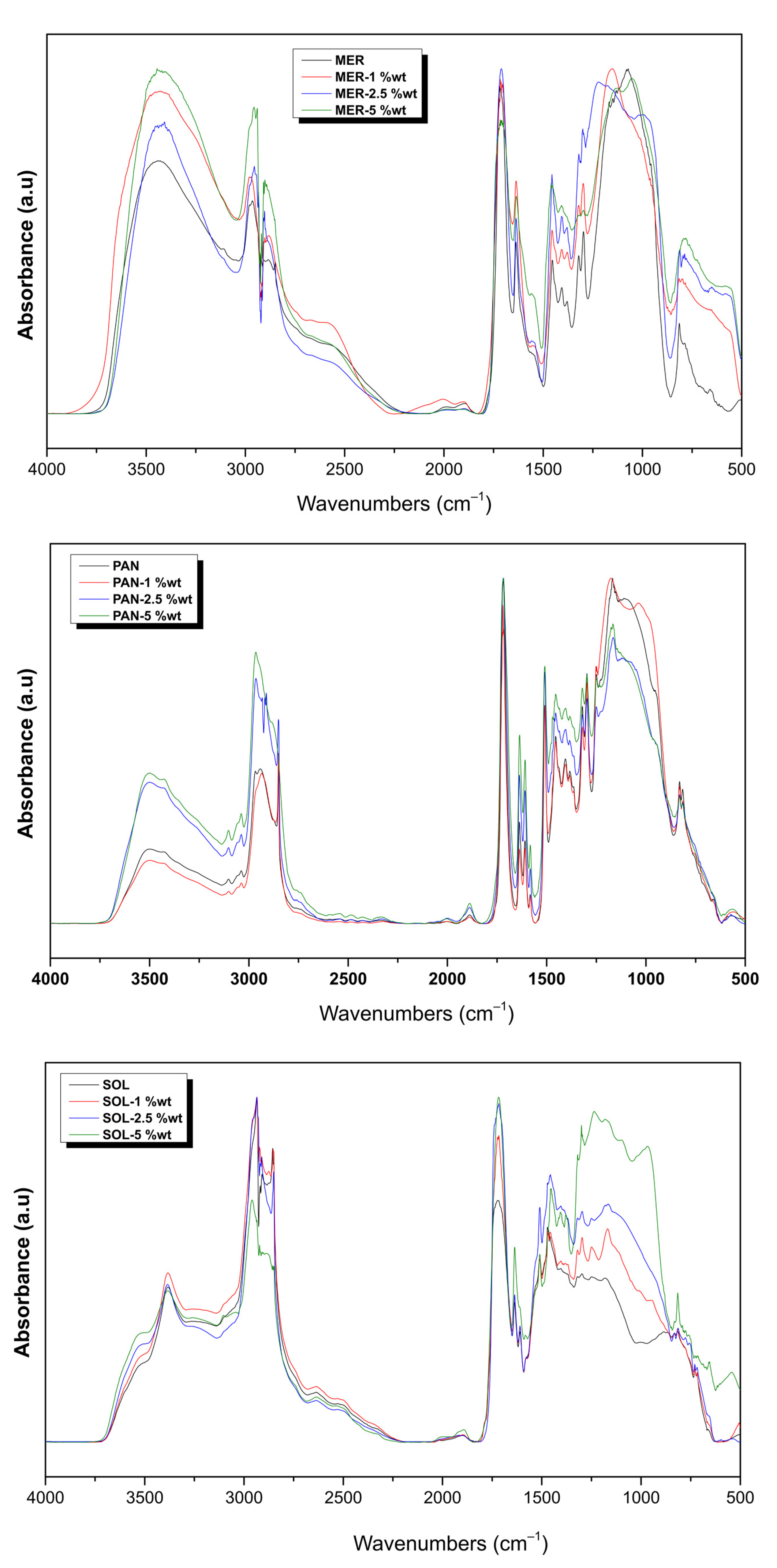
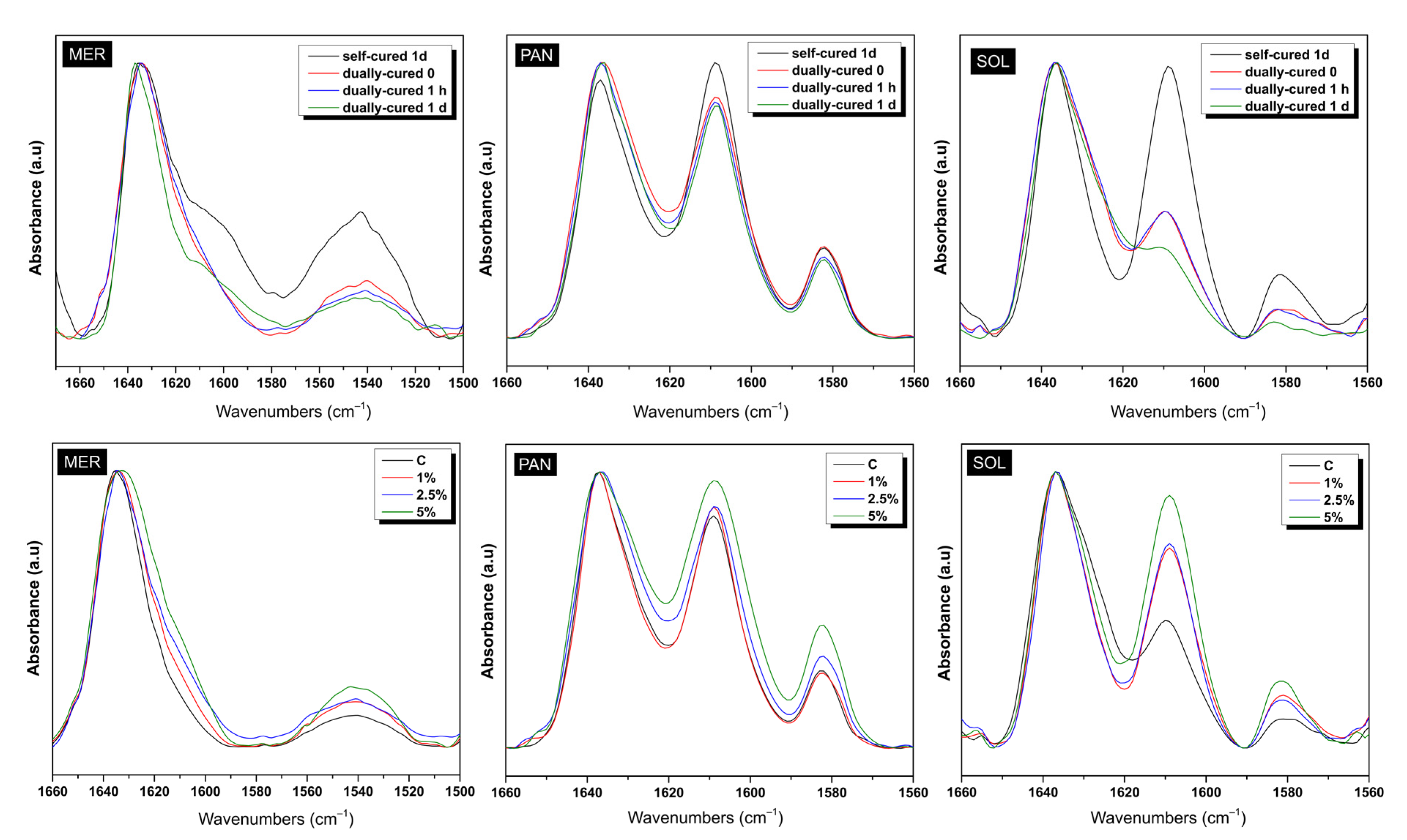
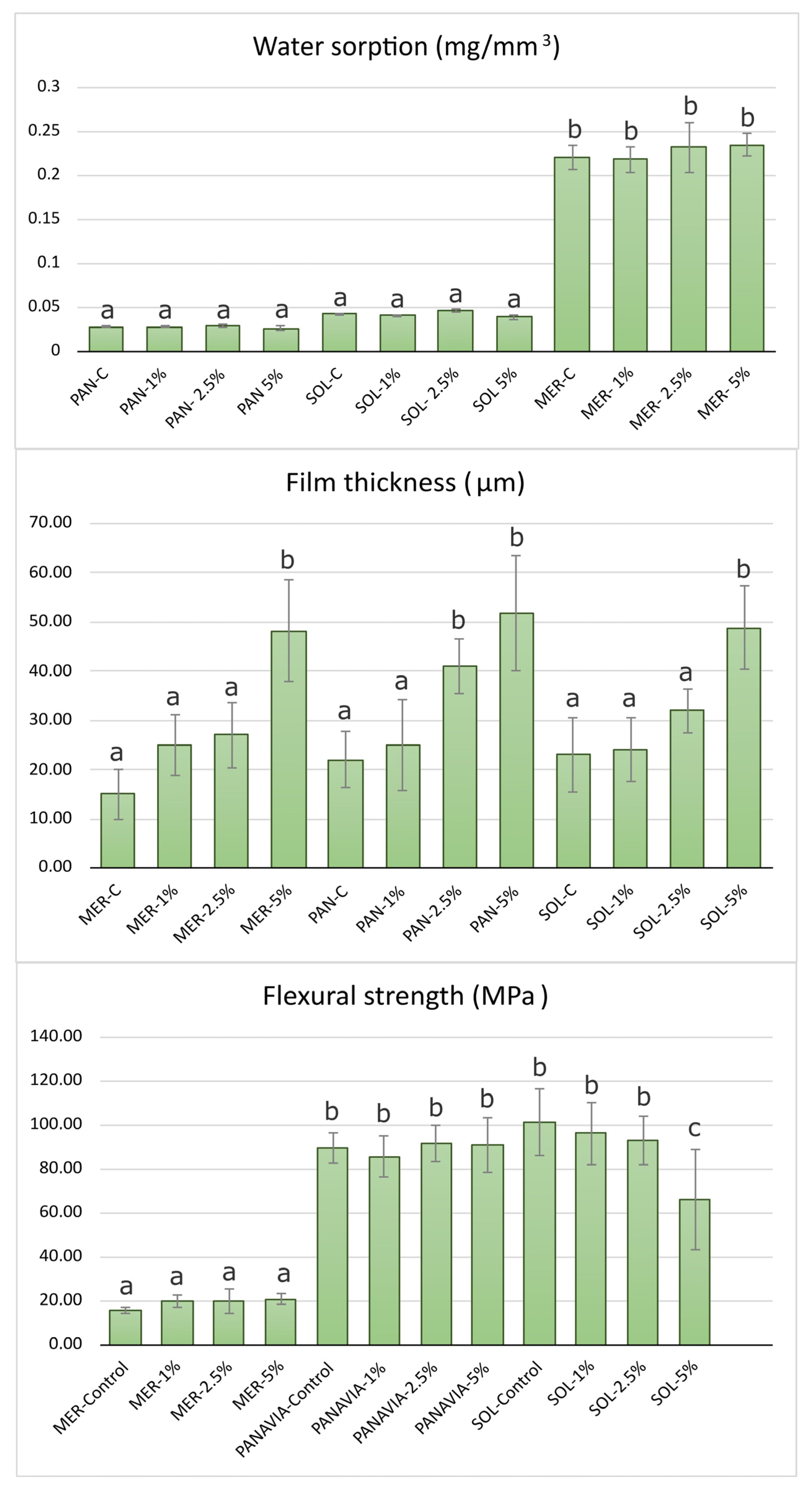
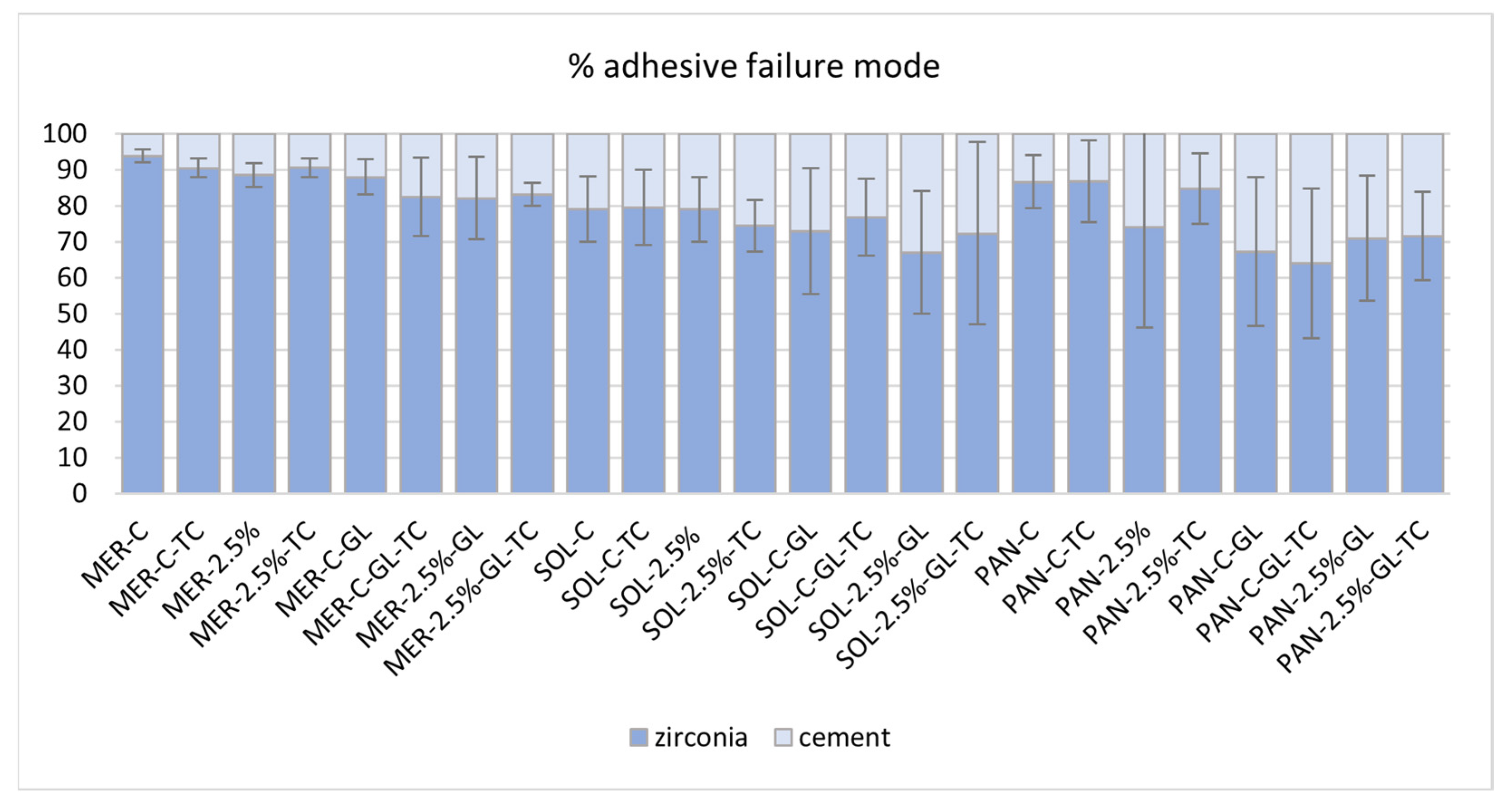
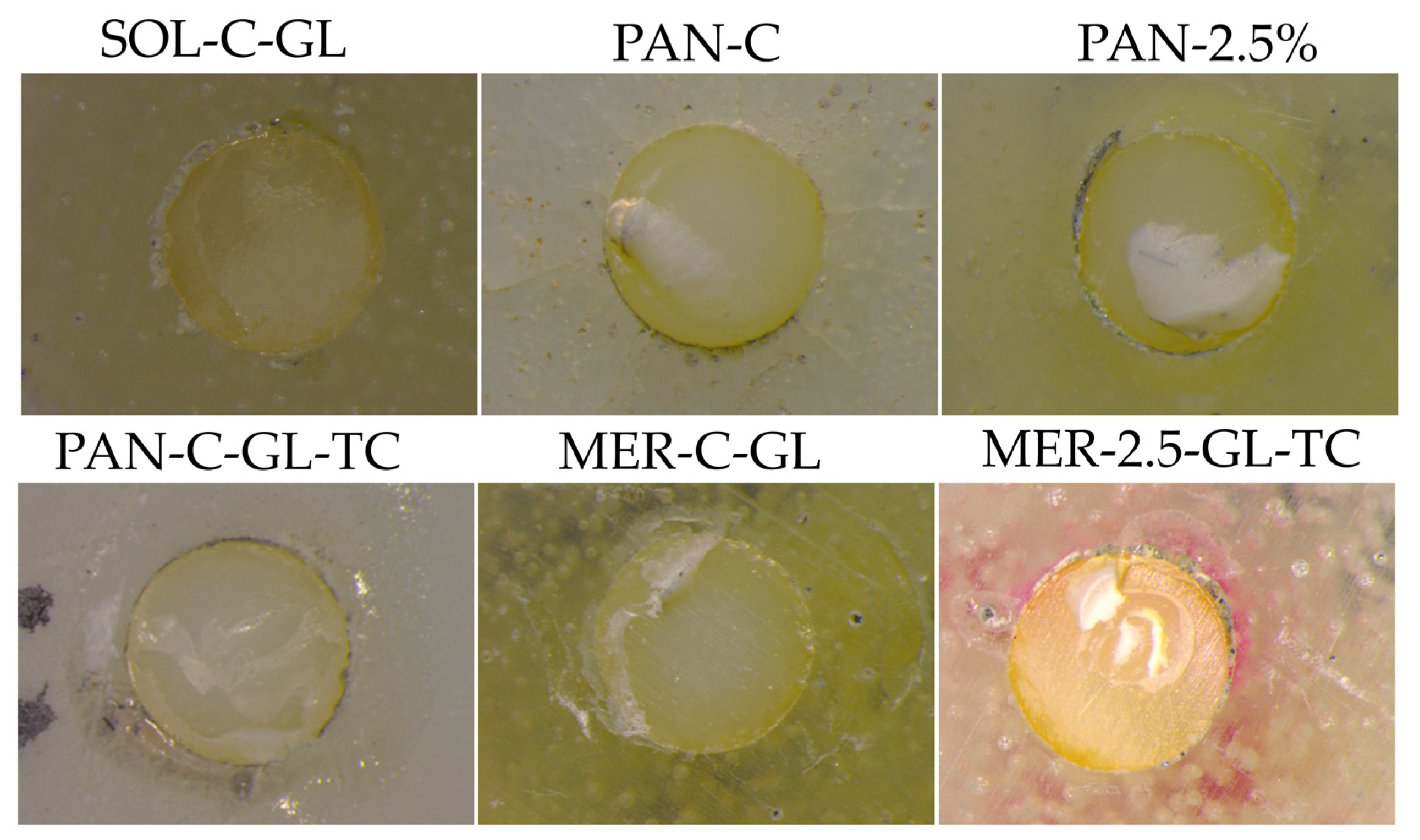

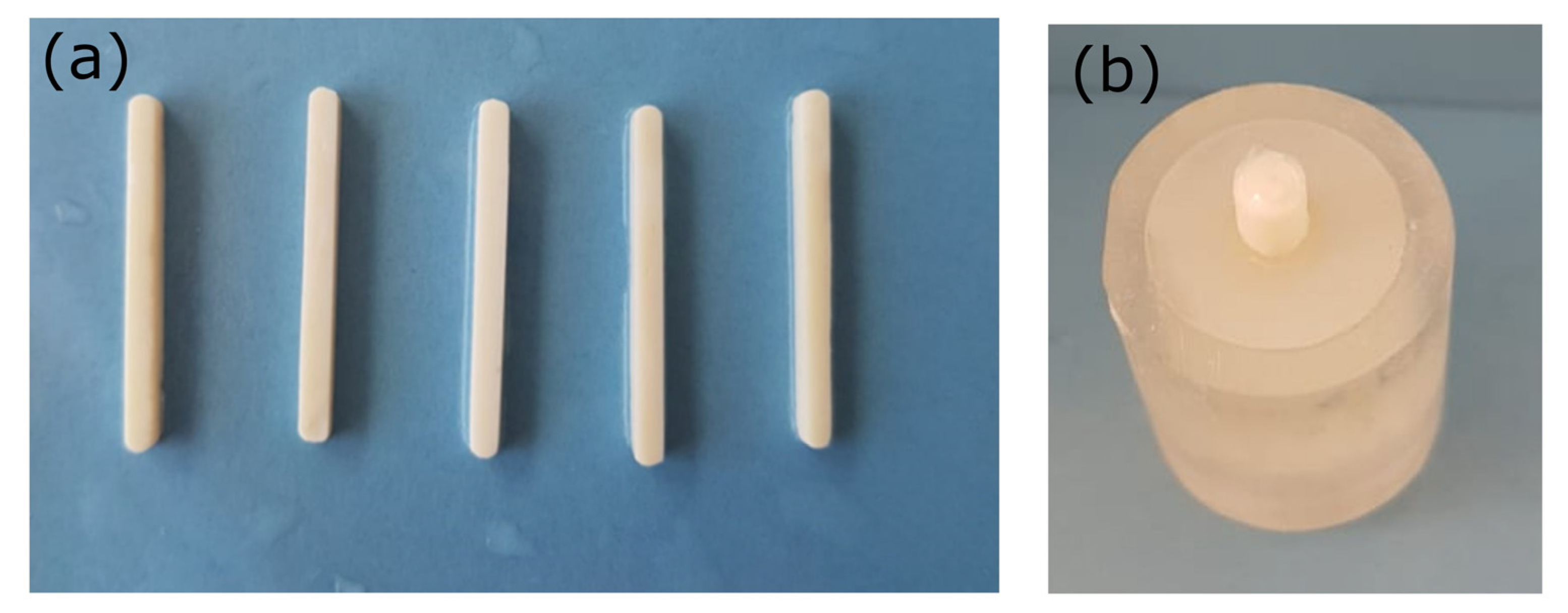
| Time | Sample | DC% | Sample | DC% | Sample | DC% |
|---|---|---|---|---|---|---|
| t = 0 | MER-C | 0.0 | PAN-C | 0.0 | SOL-C | 0.0 |
| t = 1 h | 30.6 ± 1.2 a | 24.6 ± 3.2 a | 31.2 ± 0.8 a | |||
| t = 1 d | 39.9 ± 2.4 b | 32.0 ± 2.4 b | 41.1 ± 1.1 b | |||
| t = 0 | MERdual | 60.6 ± 1.5 c | PANdual | 64.4 ± 1.1 c | SOLdual | 77.8 ± 2.6 c |
| t = 1 h | 63.9 ± 0.8 c | 63.5 ± 0.8 c | 78.8 ± 2.4 c | |||
| t = 1 d | 62.6 ± 1.2 c | 71.8 ± 1.5 d | 78.5 ± 2.4 c | |||
| t = 0 | MER-1dual | 58.3 ± 2.0 c,d | PAN-1dual | 57.4 ± 2.3 e | SOL-1dual | 75.5 ± 1.2 c |
| t = 1 h | 58.6 ± 1.0 d | 60.2 ± 2.1 c,e | 76.2 ± 1.6 c | |||
| t = 1 d | 59.4 ± 1.6 c,d | 61.3 ± 1.8 c | 77.0 ± 0.9 c | |||
| t = 0 | MER-2.5dual | 56.8 ± 2.5 d | PAN-2.5dual | 53.3 ± 3.1 e | SOL-2.5dual | 66.3 ± 2.1 e |
| t = 1 h | 59.3 ± 0.6 c,d | 55.1 ± 2.9 e | 68.4 ± 0.8 e | |||
| t = 1 d | 60.6 ± 0.7 c,d | 56.3 ± 2.4 e | 73.8 ± 1.9 c,e | |||
| t = 0 | MER-5dual | 50.8 ± 2.4 e | PAN-5dual | 55.1 ± 2.5 e | SOL-5dual | 61.7 ± 3.8 e |
| t = 1 h | 54.4 ± 1.9 e | 57.3 ± 1.0 e | 66.6 ± 2.1 e | |||
| t = 1 d | 59.4 ± 1.9 c,d | 58.1 ± 0.9 e | 71.3 ± 2.6 e |
| Before TC | After TC | |||
|---|---|---|---|---|
| Sample | SBS (MPa) | SBS (MPa) | Change % | p Value |
| MER−C | 3.73 ± 0.40 a | 0 ± 0 | - | - |
| MER−2.5 | 4.01 ± 0.30 a | 0 ± 0 | - | - |
| MER−GL−C | 13.02 ± 2.98 b | 15.12 ± 4.81 c | 16.12 | 0.401 |
| MER−GL−2.5 | 13.22 ± 3.42 b | 6.69 ± 1.74 b | −49.36 | 0.051 |
| SOL−C | 4.69 ± 1.91 d | 1.46 ± 0.24 f | −68.91 | 0.304 |
| SOL−2.5 | 7.83 ± 4.32 d | 0 ± 0 | −100 | - |
| SOL−GL−C | 20.38 ± 5.63 e | 6.45 ± 2.39 f | −68.35 | <0.01 |
| SOL−GL−2.5 | 23.15 ± 1.97 e | 4.87 ± 1.38 f | −78.95 | <0.01 |
| PAN−C | 13.62 ± 5.08 g | 12.87 ± 4.41 i | −5.50 | <0.01 |
| PAN−2.5 | 12.78 ± 0.83 g | 9.00 ± 5.09 i | −29.59 | <0.01 |
| PAN−GL−C | 24.31 ± 5.65 h | 3.35 ± 1.09 j | −86.20 | <0.01 |
| PAN−GL−2.5 | 29.96 ± 7.74 h | 6.03 ± 3.22 i | −79.89 | <0.01 |
| Product’s Name | Type of Material | Composition | Filler |
|---|---|---|---|
| Solocem (Coltene, Altstätten, Switzerland) | Self-adhesive, dual-curing composite-based luting cement | Zinc oxide dental glass, urethane-dimethacrylate (UDMA), triethyleneglycol dimethacrylate (TEGDMA), 4-methacryloxyethyl trimellitate anhydride (4-META), 2-hydroxyethylmethacrylate (HEMA), dibenzoylperoxide, benzoylperoxide | Average particle size diameter 2 μm Filler particle size distribution 0.1–5 μm Filling ratio by weight wt% = 69% Inorganic fillers (barium glass, ytterbium trifluoride, spheroid mixed oxide, titanium oxide.) |
| Meron Plus QM (VOCO, Cuxhaven, Germany) | Self-curing fluoride releasing resin modified glass ionomer cement | Polyacrylic acid peroxide, BHT, methacrylates (hydroxypropyl methacrylate 10–25%, dimethacrylate 5–10%, UDMA 2.5–5%), glycerine | Fluoroaluminosilicate glass 50–100% |
| Panavia SA Cement Universal (Kuraray, Japan) | Dual-curing fluoride releasing, self-adhesive resin cement | Paste A—10-Methacryloyloxydecyl dihydrogen phosphate (MDP)—Bisphenol A diglycidylmethacrylate (Bis-GMA)—TEGDMA—Hydrophobic aromatic dimethacrylate—2-Hydroxymethacrylate (HEMA)—Silanated barium glass filler—Silanated colloidal silica—dl-Camphorquinone—Peroxide—Catalysts—Pigments Paste B—Hydrophobic aromatic dimethacrylate—Silane coupling agent—Silanated barium glass filler—Aluminum oxide filler—Surface treated sodium fluoride (Less than 1%)—dl-Camphorquinone—Accelerators—Pigments | Inorganic filler (silanated barium glass, aluminum oxide, colloidal silica) is approx. 43 vol%. The particle size 0.02–20 μm |
| Gluma bond universal (Kulzer, Germany) | Light-curing, self-conditioning all-in-one adhesive | 4-META and MDP monomers Methacrylates, Acetone Water | Contains fillers |
Disclaimer/Publisher’s Note: The statements, opinions and data contained in all publications are solely those of the individual author(s) and contributor(s) and not of MDPI and/or the editor(s). MDPI and/or the editor(s) disclaim responsibility for any injury to people or property resulting from any ideas, methods, instructions or products referred to in the content. |
© 2023 by the authors. Licensee MDPI, Basel, Switzerland. This article is an open access article distributed under the terms and conditions of the Creative Commons Attribution (CC BY) license (https://creativecommons.org/licenses/by/4.0/).
Share and Cite
Beketova, A.; Tzanakakis, E.-G.C.; Vouvoudi, E.; Anastasiadis, K.; Rigos, A.E.; Pandoleon, P.; Bikiaris, D.; Tzoutzas, I.G.; Kontonasaki, E. Zirconia Nanoparticles as Reinforcing Agents for Contemporary Dental Luting Cements: Physicochemical Properties and Shear Bond Strength to Monolithic Zirconia. Int. J. Mol. Sci. 2023, 24, 2067. https://doi.org/10.3390/ijms24032067
Beketova A, Tzanakakis E-GC, Vouvoudi E, Anastasiadis K, Rigos AE, Pandoleon P, Bikiaris D, Tzoutzas IG, Kontonasaki E. Zirconia Nanoparticles as Reinforcing Agents for Contemporary Dental Luting Cements: Physicochemical Properties and Shear Bond Strength to Monolithic Zirconia. International Journal of Molecular Sciences. 2023; 24(3):2067. https://doi.org/10.3390/ijms24032067
Chicago/Turabian StyleBeketova, Anastasia, Emmanouil-Georgios C. Tzanakakis, Evangelia Vouvoudi, Konstantinos Anastasiadis, Athanasios E. Rigos, Panagiotis Pandoleon, Dimitrios Bikiaris, Ioannis G. Tzoutzas, and Eleana Kontonasaki. 2023. "Zirconia Nanoparticles as Reinforcing Agents for Contemporary Dental Luting Cements: Physicochemical Properties and Shear Bond Strength to Monolithic Zirconia" International Journal of Molecular Sciences 24, no. 3: 2067. https://doi.org/10.3390/ijms24032067







